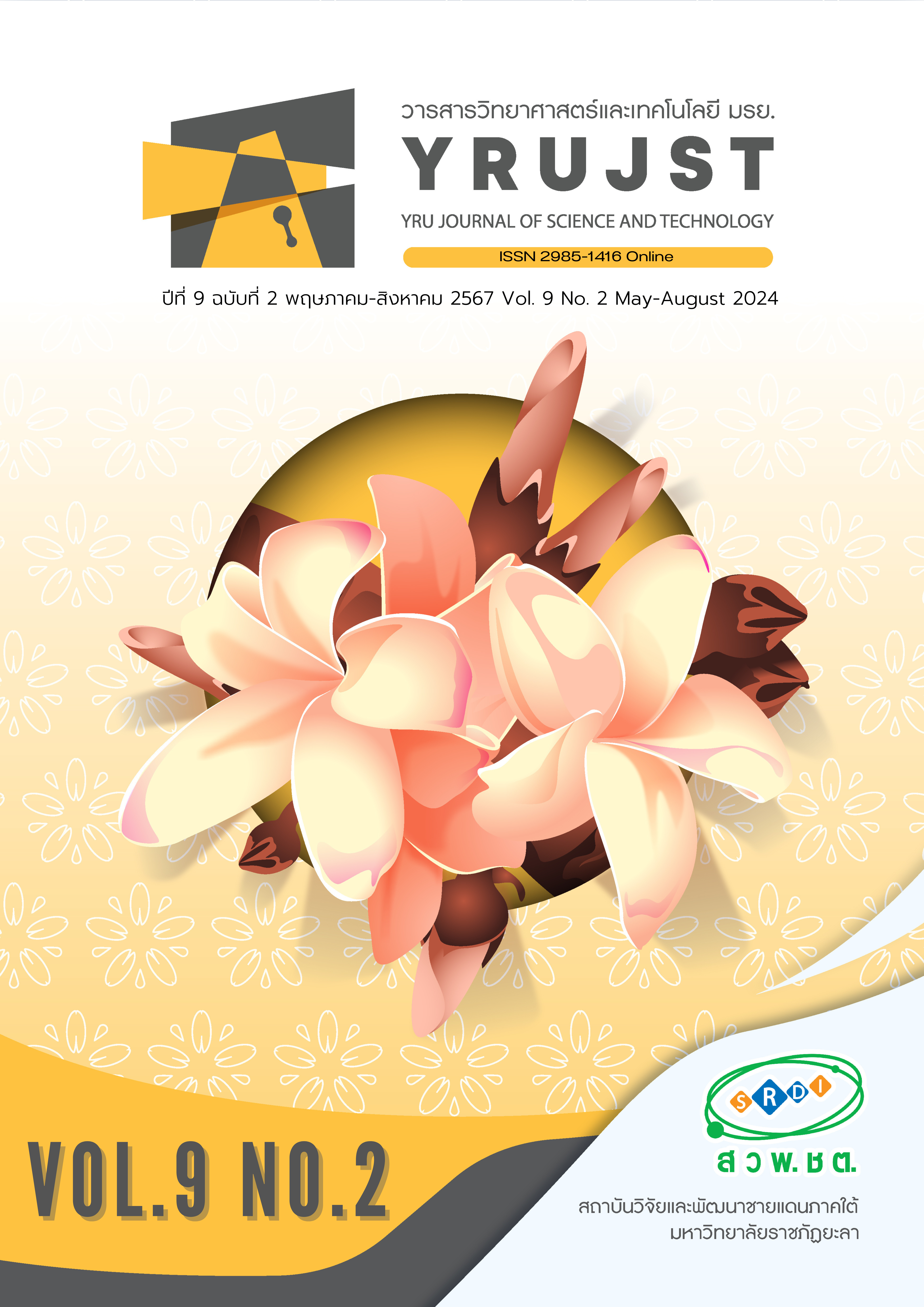ผลตกค้างของมูลไก่แกลบและการตอบสนองต่ออัตราปุ๋ยธาตุอาหารหลักของมันสำปะหลังที่ปลูกในชุดดินวาริน
Main Article Content
บทคัดย่อ
ปัญหาดินเสื่อมความอุดมสมบูรณ์ส่งผลให้ผลผลิตมันสำปะหลังในภาคตะวันออกเฉียงเหนือมีปริมาณต่ำ จึงได้ดำเนินการทดสอบผลตกค้างของมูลไก่แกลบที่ใส่ก่อนการปลูกมันสำปะหลัง 2 ปี และการตอบสนองด้านองค์ประกอบผลผลิต และการดูดใช้ธาตุอาหารหลักของมันสำปะหลังพันธุ์ห้วยบง 80 ในชุดดินวารินบริเวณแปลงเกษตรกร จ.นครราชสีมา วางแผนการทดลองแบบ Split plot จำนวน 4 ซ้ำ แปลงหลักประกอบด้วยการใส่มูลไก่แกลบอัตรา 0, 3.125, 6.25 และ 12.5 ตัน/เฮกตาร์ และแปลงรองเป็นปุ๋ยเคมีจำนวน 10 อัตรา พบว่า การใส่มูลไก่แกลบไม่ส่งผลตกค้างชัดเจนต่อผลผลิตและการดูดใช้ธาตุอาหารหลักของมันสำปะหลัง แต่มันสำปะหลังตอบสนองต่อปุ๋ยเคมีแตกต่างกันอย่างชัดเจน โดยมันสำปะหลังให้ผลผลิตหัวมันสำปะหลังสด และผลผลิตแป้งสูงสุดอย่างมีนัยสำคัญทางสถิติในแปลงที่ไม่มีการใส่มูลไก่แกลบก่อนหน้าแต่ได้รับปุ๋ยเคมีในอัตรา 100:50:100 กิโลกรัม N:P2O5:K2O/เฮกตาร์ การลดปุ๋ยฟอสฟอรัสลงส่งผลชัดเจนต่อการลดลงของผลผลิต โดยตำรับการทดลองที่ไม่มีการใส่ปุ๋ยฟอสฟอรัสได้ผลผลิตมันสำปะหลังต่ำใกล้เคียงกับการไม่ใส่ปุ๋ยธาตุอาหารหลัก มันสำปะหลังมีการดูดใช้โพแทสเซียมสูงสุด รองลงมาคือไนโตรเจน ส่วนฟอสฟอรัสถูกดูดใช้น้อยที่สุด โดยมันสำปะหลังมีการดูดใช้ธาตุอาหารหลักในส่วนหัวมากที่สุด รองลงมาคือ กิ่งก้านใบ ลำต้น และเหง้าตามลำดับ แสดงให้เห็นว่า การใส่มูลไก่แกลบในดินทรายควรใส่ในต่อเนื่องทุกปีในอัตราที่เหมาะสมร่วมกับการจัดการปุ๋ยธาตุอาหารหลักเพื่อรักษาปริมาณผลผลิตของมันสำปะหลังให้อยู่ในระดับที่น่าพึงพอใจ ขณะที่การใส่ปุ๋ยเคมีธาตุอาหารหลักอัตรา 100:50:100 กิโลกรัม N:P2O5:K2O/เฮกตาร์ยังคงเป็นอัตราที่เหมาะสมที่สุดหากไม่มีการใส่มูลไก่แกลบเพื่อปรับปรุงดิน
Article Details

อนุญาตภายใต้เงื่อนไข Creative Commons Attribution-NonCommercial-NoDerivatives 4.0 International License.
บทความ ข้อมูล เนื้อหา รูปภาพ ฯลฯ ที่ได้รับการเผยแพร่ในวารสารวิทยาศาสตร์และเทคโนโลยี มรย. นี้ ถือเป็นลิขสิทธิ์ของวารสารวิทยาศาสตร์และเทคโนโลยี มรย. หากบุคคลหรือหน่วยงานใดต้องการนำทั้งหมดหรือส่วนหนึ่งส่วนใดไปเผยแพร่ต่อหรือกระทำการใดๆ จะต้องได้รับอนุญาตเป็นลายลักษณ์อักษรจากวารสารวิทยาศาสตร์และเทคโนโลยี มรย. ก่อนเท่านั้น
เอกสารอ้างอิง
Adeleye, E. O., Ayeni, L. S. & Ojeniyi, S. O. (2010). Effect of poultry manure on soil physico-chemical properties, leaf nutrient contents and yield of yam (Dioscorea rotundata) on Alfisol in southwestern Nigeria. Journal of American Science, 6(10), 871–878.
Boonrawd, S., Anusontpornperm, S., Thanachit, S., Kheoruenromne, I. & Janjirawuttikul, N. (2021). Characteristics and fertility capability of cassava growing soils under different annual rainfall conditions in Northeast Thailand. Khon Kaen Agricultural Journal, 49(4), 1034–1046.
Bainbridge, Z., Tomlins, K., Wellings, K. & Westby, A. (1996). Methods for assessing quality characteristics of non-grain starch staples. (Part 3. Laboratory methods). UK: Natural Resources Institute.
Chaem-Ngern, C., Anusontpornperm, S., Thanachit, S. & Kheoruenromne, I. (2020). Response of cassava, Huay Bong 80 variety, grown in an Ustic Quartzipsamment, to chicken manure and potassium fertilizer. Communications in Soil Science and Plant Analysis, 51(22), 2765–2777.
Chatkaewvorakul, S., Anusontpornperm, S., Thanachit, S., Kheoruenromne, I. & Phun-iam, M. (2022). Cumulative effect of soil organic amendments on yield and nutrient uptake of cassava planted in Yasothon soil series. Agricultural Science Journal, 53(2), 143–161. (in Thai)
Chuensombat, W. S., Anusontpornperm, S., Thanachit, S. & Kheoruenromne, I. (2021). Cumulative effect of perlite and chicken manure on chemical fertilizer and Zn foliar application rates used for cassava in Warin soil series. Khon Kaen Agricultural Journal, 49(6), 1515–1529. (in Thai)
Howeler, R. H. (2014). Sustainable soil and crop management of cassava in Asia: A reference manual. Cali: Centro Internacional de Agricultura Tropical (CIAT).
Howeler, R. H, Lutaladio, N. & Thomas, G. (2013). Save and grow: cassava: A guide to sustainable production intensification. Rome: Food and Agriculture Organization of the United Nations.
Klongtham, R., Anusontpornperm, S., Thanachit, S. & Kheoruenromne, I. (2020). Cumulative effect of chicken manure, cassava starch manufacturing wastes and chemical fertilizer on cassava grown in Yasothon soil series. Khon Kaen Agricultural Journal, 48(6), 1292–1303. (in Thai)
Nilnoree, T., Anusontpornperm, S., Thanachit, S., Kheoruenromne, I. & Petprapai, P. (2016). Effect of chicken manure and organic wastes from cassava starch manufacturing plant on cassava grown on Dan Khun Thot soil. Khon Kaen Agricultural Journal, 44(1), 167–178.
OAE. (2023). Annual yield of cassava in Thailand from 2014 to 2022 with a forecast to 2023 (in metric tons per rai) [Graph] [online]. Retrieved July 20, 2023, from:
https://www.statista.com/statistics/1391219/thailand-cassava-annual-yield/.
Omondi, J. O., Lazarovitch, N., Rachmilevitch, S. & Yermiyahu, U. (2019). Phosphorus affects storage root yield of cassava through root numbers. Journal of Plant Nutrition, 42(17), 2070–2079.
Prombut, N., Anusontpornperm, S., Thanachit, S., Kheoruenromne, I. & Phun-Iam, M. (2022). Response of cassava to potassium fertilization in a tropical sandy Typic Paleustult amended with burnt rice husk for two-consecutive years. Communications in Soil Science and Plant Analysis, 53(14), 1823–1840.
Phun-iam, M., Anusontpornperm, S., Thanachit, S. & Kheoruenromne, I. (2018). Yield response of cassava Huay Bong 80 variety grown in an Oxyaquic Paleustult to cassava starch waste and nitrogen fertilizer. Agriculture and Natural Resources, 52(6), 573-580.
Santos, N. S., Alves, J. M. A., Uchôa, S. C. P., Oliveira, N. T. & Albuquerque, J. A. A. (2014). Absorption of macronutrients by cassava in different harvest dates and dosages of nitrogen. Revista Ciência Agronômica, 45, 633–640.
Sittibusaya, C., (1996). Strategies for developing fertilizer recommendations for field crops. Bangkok: Ministry of Agriculture and Cooperatives.
Thanimmarn, N., Anusontpornperm, S., Suddhiprakarn, A., Thanachit, S. & Petprapai, P. (2014). Use of perlite, chicken manure and zinc foliar application for improving yields of cassava grown in Yasothon soil. Khon Kaen Agricultural Journal, 42(2), 189–200. (in Thai)
Uppapanpongchai, P., Anusontpornperm, S., Thanachit, S., Kheoruenromne, I., Phun-iam, M. (2022). Cumulative effect of phosphorus fertilizer on yield and major nutrient uptake of cassava planted in Yasothon soil series and soil property changes. Agricultural Science Journal, 53(2), 188-208. (in Thai)


